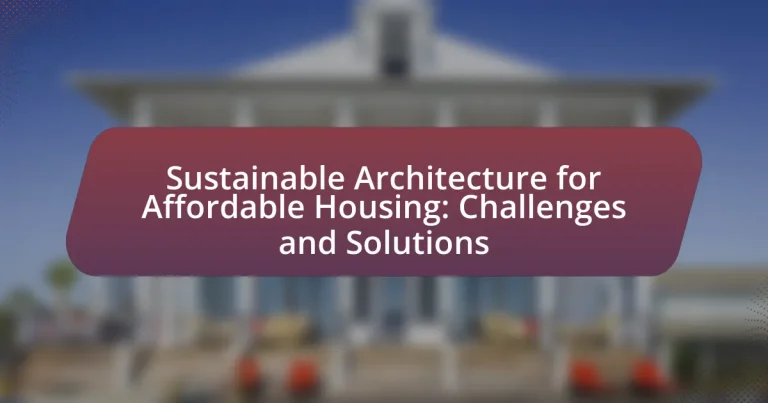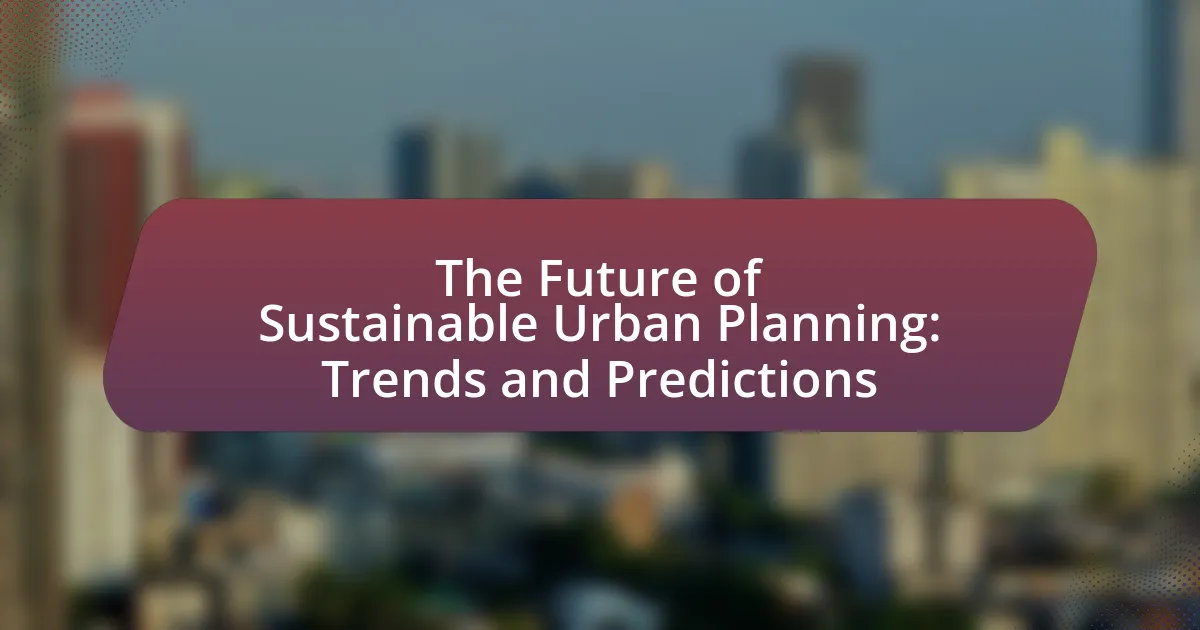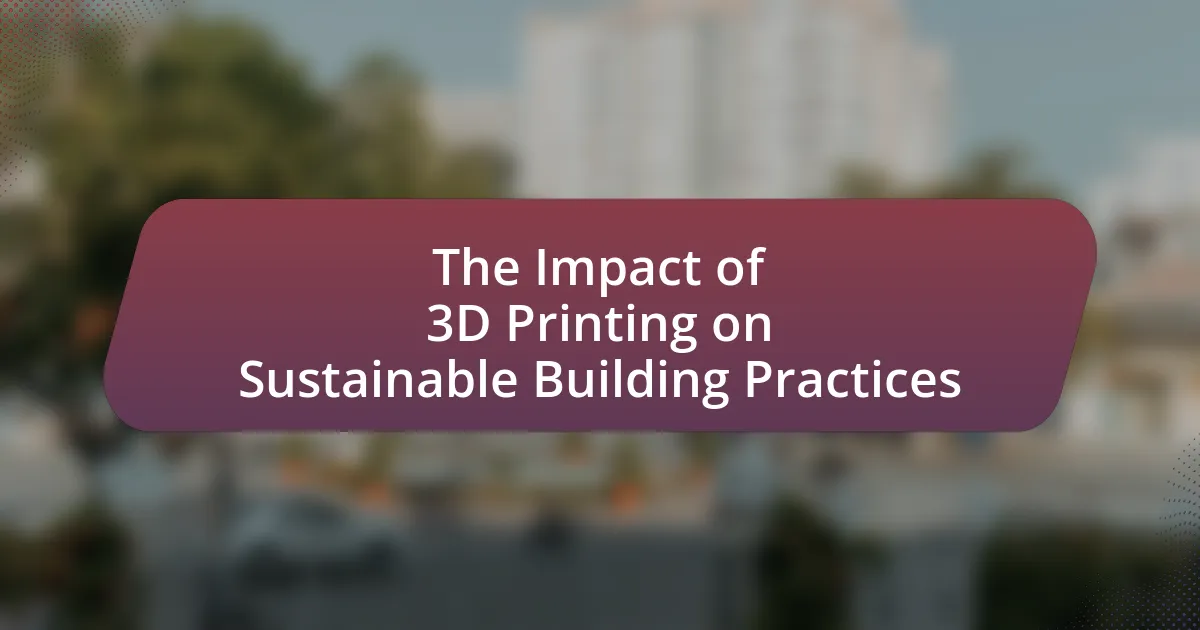Sustainable architecture for affordable housing focuses on designing and constructing homes that are environmentally friendly and economically accessible to low- and middle-income families. This approach incorporates energy-efficient systems, sustainable materials, and innovative design strategies to minimize resource consumption and enhance livability. The article explores how sustainable architecture contributes to affordable housing by reducing construction and operational costs, addresses environmental concerns through eco-friendly practices, and highlights the importance of affordable housing in promoting economic stability and social equity. Additionally, it discusses the challenges faced in implementing sustainable architecture, including financial barriers and regulatory hurdles, while proposing solutions such as community engagement and the use of innovative materials to overcome these obstacles.

What is Sustainable Architecture for Affordable Housing?
Sustainable architecture for affordable housing refers to the design and construction of housing that minimizes environmental impact while being economically accessible to low- and middle-income families. This approach integrates energy-efficient systems, sustainable materials, and innovative design strategies to reduce resource consumption and enhance livability. For instance, the use of renewable energy sources, such as solar panels, and sustainable materials, like recycled steel and bamboo, can significantly lower utility costs and environmental footprints. Studies show that sustainable housing can reduce energy consumption by up to 30%, making it a viable solution for affordable living.
How does sustainable architecture contribute to affordable housing?
Sustainable architecture contributes to affordable housing by reducing construction and operational costs through energy-efficient designs and materials. By utilizing renewable resources, such as solar panels and sustainable building materials, projects can lower energy consumption and maintenance expenses, making housing more affordable for residents. For instance, a study by the U.S. Green Building Council found that green buildings can reduce energy costs by 30% to 50%, directly impacting the affordability of housing. Additionally, sustainable architecture often incorporates efficient land use and community planning, which can lead to lower infrastructure costs and increased access to public services, further enhancing affordability for low-income families.
What principles define sustainable architecture in the context of housing?
Sustainable architecture in the context of housing is defined by principles such as energy efficiency, resource conservation, and social equity. Energy efficiency involves designing homes that minimize energy consumption through passive solar design, high-performance insulation, and energy-efficient appliances. Resource conservation emphasizes the use of sustainable materials, such as recycled or locally sourced products, to reduce environmental impact. Social equity ensures that housing is accessible and affordable for diverse populations, promoting inclusive communities. These principles are supported by research indicating that sustainable housing can reduce utility costs by up to 30% and improve residents’ quality of life through healthier living environments.
How does sustainable architecture address environmental concerns?
Sustainable architecture addresses environmental concerns by integrating eco-friendly design principles that minimize resource consumption and reduce waste. This approach includes utilizing renewable materials, optimizing energy efficiency through passive solar design, and implementing water conservation techniques. For instance, buildings designed with green roofs can reduce urban heat islands and improve air quality, while energy-efficient systems can lower greenhouse gas emissions. According to the U.S. Green Building Council, green buildings can reduce energy use by 30% to 50% compared to conventional structures, demonstrating the effectiveness of sustainable architecture in mitigating environmental impacts.
Why is affordable housing important in today’s society?
Affordable housing is crucial in today’s society because it ensures that individuals and families have access to safe, stable, and adequate living conditions. This access is essential for promoting economic stability, reducing homelessness, and fostering community development. According to the National Low Income Housing Coalition, in 2021, there was a shortage of 7 million affordable rental homes for extremely low-income renters, highlighting the urgent need for affordable housing solutions. Furthermore, affordable housing contributes to improved health outcomes, as stable housing is linked to better physical and mental health, thereby reducing healthcare costs for individuals and society as a whole.
What are the social implications of inadequate affordable housing?
Inadequate affordable housing leads to significant social implications, including increased homelessness, social inequality, and diminished community cohesion. When affordable housing is scarce, individuals and families are often forced into substandard living conditions or become homeless, which exacerbates public health issues and strains social services. According to the National Alliance to End Homelessness, in 2020, over 580,000 people experienced homelessness in the United States, highlighting the direct correlation between housing affordability and homelessness rates. Furthermore, inadequate housing contributes to social inequality, as marginalized groups, including low-income families and minorities, are disproportionately affected, perpetuating cycles of poverty and limiting access to education and employment opportunities. This lack of stable housing undermines community cohesion, as residents may frequently move or live in transient conditions, reducing social ties and community engagement.
How does affordable housing impact economic stability?
Affordable housing significantly enhances economic stability by reducing housing cost burdens on low- and moderate-income families. When families spend less on housing, they have more disposable income to invest in education, healthcare, and local businesses, which stimulates economic growth. According to a report by the National Low Income Housing Coalition, every $1 invested in affordable housing generates approximately $1.50 in economic returns, demonstrating a clear link between affordable housing and broader economic benefits. Additionally, stable housing reduces reliance on social services, further contributing to economic resilience within communities.

What challenges does sustainable architecture face in affordable housing?
Sustainable architecture faces significant challenges in affordable housing, primarily due to high upfront costs and limited access to sustainable materials. These financial barriers often deter developers from incorporating eco-friendly designs and technologies, which can lead to increased construction expenses. For instance, a study by the National Association of Home Builders indicates that sustainable building materials can cost up to 20% more than conventional options, making it difficult for affordable housing projects to remain within budget constraints. Additionally, regulatory hurdles and lack of incentives for sustainable practices further complicate the integration of green architecture in low-income housing developments.
What are the financial barriers to implementing sustainable architecture?
The financial barriers to implementing sustainable architecture include high initial costs, limited access to financing, and the perception of increased risk among investors. High initial costs arise from the premium prices of sustainable materials and technologies, which can deter developers from pursuing green building projects. Limited access to financing is often due to a lack of awareness among lenders about the long-term benefits of sustainable architecture, leading to fewer funding options. Additionally, investors may perceive sustainable projects as riskier due to uncertainties in market demand and potential returns, further complicating financing efforts. These factors collectively hinder the widespread adoption of sustainable architecture in affordable housing initiatives.
How do initial costs affect the adoption of sustainable building practices?
Initial costs significantly hinder the adoption of sustainable building practices by increasing the financial burden on developers and homeowners. High upfront expenses associated with sustainable materials, technologies, and design often deter stakeholders from pursuing these environmentally friendly options. For instance, a study by the National Institute of Building Sciences found that while sustainable buildings can lead to long-term savings through energy efficiency, the initial investment can be 10-20% higher than conventional construction. This financial barrier can lead to a preference for traditional building methods, ultimately slowing the transition to more sustainable practices in the housing sector.
What funding options are available for sustainable affordable housing projects?
Funding options for sustainable affordable housing projects include government grants, low-interest loans, tax credits, and private investments. Government grants, such as those from the U.S. Department of Housing and Urban Development, provide financial assistance specifically for sustainable initiatives. Low-interest loans, often available through state housing finance agencies, help reduce the cost of financing. Tax credits, like the Low-Income Housing Tax Credit, incentivize developers to invest in affordable housing. Additionally, private investments from impact investors focus on projects that yield social and environmental benefits, further supporting the development of sustainable affordable housing.
What regulatory challenges exist for sustainable architecture in affordable housing?
Regulatory challenges for sustainable architecture in affordable housing include stringent building codes, zoning laws, and financing restrictions. These regulations often prioritize cost and speed over sustainability, limiting the integration of eco-friendly materials and technologies. For instance, many local building codes do not accommodate innovative sustainable practices, which can hinder the adoption of energy-efficient designs. Additionally, zoning laws may restrict the density and type of housing that can be built, making it difficult to implement sustainable solutions in urban areas. Furthermore, financing for affordable housing projects often comes with conditions that do not support sustainable initiatives, creating a barrier to the development of environmentally friendly housing options.
How do zoning laws impact sustainable housing initiatives?
Zoning laws significantly impact sustainable housing initiatives by dictating land use, density, and building design, which can either facilitate or hinder the development of eco-friendly housing. For instance, restrictive zoning regulations may limit the construction of multi-family units or mixed-use developments, which are often more sustainable due to shared resources and reduced land consumption. Conversely, progressive zoning policies that promote higher density and mixed-use developments can enhance sustainability by encouraging walkability, reducing reliance on automobiles, and optimizing resource use. Research from the American Planning Association indicates that cities with flexible zoning laws can better accommodate innovative housing solutions, thereby supporting sustainability goals.
What building codes must be considered for sustainable designs?
Building codes that must be considered for sustainable designs include the International Green Construction Code (IgCC), ASHRAE 90.1 for energy efficiency, and local zoning regulations that promote sustainable practices. The IgCC provides a framework for sustainable construction practices, ensuring that buildings meet specific environmental performance standards. ASHRAE 90.1 sets minimum energy efficiency requirements for buildings, which is crucial for reducing energy consumption and greenhouse gas emissions. Local zoning regulations may include requirements for green roofs, permeable paving, and the use of renewable energy sources, which further support sustainable design initiatives. These codes collectively ensure that sustainable designs are not only environmentally friendly but also compliant with legal standards.

What solutions exist to overcome challenges in sustainable architecture for affordable housing?
Solutions to overcome challenges in sustainable architecture for affordable housing include the use of innovative building materials, integration of renewable energy systems, and implementation of efficient design practices. Innovative building materials, such as recycled or locally sourced materials, reduce environmental impact and costs. For instance, using bamboo or rammed earth can lower construction expenses while enhancing sustainability. Integration of renewable energy systems, like solar panels and wind turbines, can significantly decrease utility costs for residents, making housing more affordable in the long term. Efficient design practices, such as passive solar design and high-performance insulation, optimize energy use and reduce operational costs. According to the U.S. Department of Energy, homes designed with these principles can save up to 30% on energy bills, further supporting affordability.
How can innovative materials contribute to sustainable affordable housing?
Innovative materials can significantly enhance sustainable affordable housing by reducing costs, improving energy efficiency, and minimizing environmental impact. For instance, materials like bamboo and recycled steel are not only cost-effective but also have lower carbon footprints compared to traditional building materials. According to a study by the World Resources Institute, using sustainable materials can reduce construction waste by up to 90%, thereby promoting resource efficiency. Additionally, innovations such as insulated concrete forms and advanced composites improve thermal performance, leading to lower energy consumption for heating and cooling. These advancements contribute to the overall sustainability of housing projects, making them more affordable in the long run.
What are the benefits of using recycled materials in construction?
Using recycled materials in construction significantly reduces environmental impact and resource consumption. Recycled materials help decrease landfill waste, with construction and demolition debris accounting for approximately 25-30% of total waste in many regions. Additionally, utilizing recycled materials can lower energy consumption during production, as it often requires less energy compared to manufacturing new materials. For instance, using recycled steel can save up to 74% of the energy needed to produce new steel. Furthermore, incorporating recycled materials can lead to cost savings, as they are often less expensive than virgin materials, making construction projects more economically viable.
How do energy-efficient technologies enhance sustainability?
Energy-efficient technologies enhance sustainability by reducing energy consumption and minimizing environmental impact. These technologies, such as LED lighting, high-efficiency HVAC systems, and smart building management systems, lower greenhouse gas emissions and decrease reliance on fossil fuels. For instance, according to the U.S. Department of Energy, implementing energy-efficient measures can reduce energy use in buildings by 30% to 50%, significantly contributing to sustainability goals. Additionally, energy-efficient technologies often lead to cost savings over time, making them economically viable while promoting a sustainable future.
What role do community engagement and education play in sustainable housing solutions?
Community engagement and education are crucial in developing sustainable housing solutions as they foster collaboration, increase awareness, and empower residents. Engaging the community ensures that housing projects reflect the needs and preferences of local populations, leading to higher acceptance and long-term sustainability. Education equips residents with knowledge about sustainable practices, enabling them to maintain and improve their living environments. For instance, studies show that communities involved in the planning process are more likely to adopt energy-efficient practices, resulting in a 20% reduction in energy consumption in some projects. This evidence highlights the importance of integrating community input and educational initiatives in achieving effective and sustainable housing solutions.
How can community involvement improve project outcomes?
Community involvement can significantly improve project outcomes by ensuring that the needs and preferences of local residents are integrated into the planning and execution phases. Engaging the community fosters a sense of ownership and accountability, which can lead to increased support for the project and better alignment with local values. For instance, a study by the American Planning Association found that projects with community engagement are 30% more likely to succeed in meeting their objectives, as they are tailored to the specific context and requirements of the community. This collaborative approach not only enhances the relevance of the project but also encourages sustainable practices that reflect the community’s aspirations and environmental considerations.
What educational programs can promote sustainable practices among builders and residents?
Educational programs that can promote sustainable practices among builders and residents include workshops on green building techniques, certification courses for sustainable construction, and community outreach initiatives focused on energy efficiency. These programs educate participants on best practices such as using renewable materials, implementing energy-efficient designs, and understanding local environmental regulations. For instance, the U.S. Green Building Council offers Leadership in Energy and Environmental Design (LEED) certification courses, which have been shown to increase awareness and application of sustainable practices in the construction industry. Additionally, local governments often run programs that provide resources and training for residents on sustainable living, which can lead to increased adoption of eco-friendly practices in their homes.
What best practices can be adopted for successful sustainable affordable housing projects?
Successful sustainable affordable housing projects can adopt best practices such as community engagement, use of local materials, energy-efficient design, and integration of green technologies. Community engagement ensures that the needs and preferences of residents are met, fostering a sense of ownership and satisfaction. Utilizing local materials reduces transportation costs and supports the local economy, while energy-efficient designs lower utility costs and enhance sustainability. The integration of green technologies, such as solar panels and rainwater harvesting systems, further contributes to environmental sustainability and reduces long-term operational costs. These practices are supported by studies indicating that community involvement and sustainable design principles lead to higher satisfaction and lower environmental impact in housing projects.
How can collaboration between stakeholders enhance project success?
Collaboration between stakeholders enhances project success by fostering diverse perspectives and expertise, which leads to more innovative solutions. When stakeholders, such as architects, builders, community members, and government officials, work together, they can identify potential challenges early and develop strategies to address them effectively. For instance, a study by the Project Management Institute found that projects with high stakeholder engagement are 20% more likely to succeed in meeting their objectives. This collaborative approach not only improves communication but also aligns goals, ensuring that all parties are invested in the project’s outcome, ultimately resulting in more sustainable and affordable housing solutions.
What are the key elements of a successful sustainable housing initiative?
Key elements of a successful sustainable housing initiative include energy efficiency, use of sustainable materials, community engagement, and affordability. Energy efficiency is crucial as it reduces utility costs and environmental impact; for instance, homes designed to meet or exceed Energy Star standards can save homeowners up to 30% on energy bills. The use of sustainable materials, such as recycled or locally sourced products, minimizes resource depletion and supports local economies. Community engagement ensures that the housing meets the needs of residents, fostering a sense of ownership and responsibility. Lastly, affordability is essential to ensure that sustainable housing is accessible to low-income families, with programs like the Low-Income Housing Tax Credit in the United States demonstrating how financial incentives can promote the development of affordable, sustainable homes.





